|
|
Baseball
Did You Know? – VIII
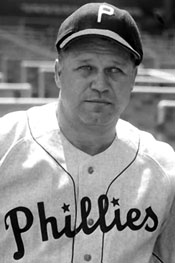
Jimmie Foxx
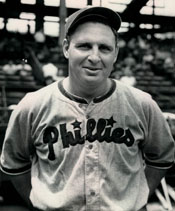
Ben Chapman
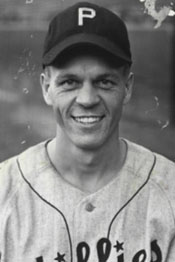
Andy Karl
|
Now Pitching - Jimmie Foxx
Jimmie Foxx hit 534 HRs over a 20-year career that began with the Philadelphia Athletics when he was 17.
- He led the AL in HRs in 1932 with 58 and 1933 with 48, then 1935 (36 roundtrippers) and '39 (35 clouts).
- In that incredible two-year span of 1932-33, he also drove in 169 and 163 runs to top the league in that category. He knocked home 175 in 1938 to again lead the Junior Circuit.
- Starting out as a C, Jimmie also played 1B, 3B, LF, and RF for the A's and Red Sox.
Known as "Double X" and the "Beast," Jimmie finished his career with the last-place Phillies in 1945.
- Manager Ben Chapman approached Foxx and told him: We're desperate. Would you mind getting yourself into shape to pitch? We don't have anyone who can get the ball over the plate.
- Foxx replied, I couldn't go nine innings under any conditions. I'm not even sure I could get anyone out.
- Chapman responded, Just hang in there as long as you can. If by some miracle, you could last five innings, that's all I'll ask. I'll take you right out.
- Jimmie's pitching career at that point had consisted of a 1-2-3 inning with one K for the Red Sox in 1939.
Foxx started the second game of a doubleheader against the Reds on August 19, 1945. Like any other pitcher, he batted ninth - undoubtedly for the first time in his career.
- After five innings, Jimmie had surrendered only one hit and one run. So Chapman left him in. [Some accounts have him pitching a no-hitter through six, but the box score reveals a hit in the 2nd.]
- The Reds went down 1-2-3 in the sixth.
- Finally, in the seventh, after getting the first two batters, Foxx ran out of gas, surrendering three straight singles to cut the score to 4-2, Phils.
- Chapman pulled Jimmie at that point, and the 10,418 fans at Shibe Park gave their substitute hurler a warm ovation.
- Reliever Andy Karl held the lead to give Foxx his first victory as a pitcher.
Buoyed by the performance, Chapman sent Foxx to the hill eight more times in 1945.
- Jimmie pitched a total of 22 2/3 innings. He gave up 13 hits and four runs for an excellent ERA of 1.59.
- His main problem was 14 walks, which outnumbered his strikeouts by four.
- The victory against the Reds was his only decision as he pitched mostly as a mopup man, finishing seven games and starting only two.
- Foxx played in a total of 89 games for the '45 Phils.
- Playing mostly at 1B, he hit a respectable .268 but with only 7 HRs and 38 RBIs.
- The end of World War II brought hundreds of former big leaguers home. So Foxx retired after the '45 season.
Double X was inducted into the Hall of Fame in 1951.
|
Rough Starts for Future Hall of Famers - I
Most future Hall of Fame players did reasonably well their rookie seasons although they may not have yet shown their potential for greatness. However, two future Cooperstown inductees - one a pitcher, the other a third baseman - did not do even "reasonably well" their first years in the bigs.
19-year-old Charles "Red" Ruffing appeared in eight games for the Boston Red Sox in 1924 before joining the club full time the following season.
- Red's ERA for those first eight games? 6.65
- But it's the full year of work in 1925 that we want to focus on. Here are the stats:
9 wins, 18 losses; 5.01 ERA; 64 strikeouts vs 75 walks
- The 6'1" righthander, who lost four toes on his left foot at age 15 in a mining accident, wasn't much better the following season (1926):
6 wins, 15 losses; 4.39 ERA; 58 strikeouts vs 68 walks
- In 1928 and 1929, Red led the American League in losses - 25 and 22 respectively. An "innings eater," he also led the league in complete games in 1928 with 25.
- He continued with Boston until early in the 1930 season when he was traded to the Yankees.
- The Red Sox finished last every one of his five years with the club, topping 100 losses three times during that span.
- Owner Bob Quinn "was operating the Red Sox on a frazzled shoestring," to quote sportswriter Stanley Frank. So like the more famous Harry Frazee before him, Quinn looked for opportunities to trade ballplayers for cash.
May 6, 1930, was the turning point day in Ruffing's career.
- That was the day the Yankees traded IB-OF Cedric Durst and $50,000 to the Red Sox for Red. Reportedly, New York owner Jacob Ruppert also loaned Quinn an additional $50,000 to help him avoid a financial crisis.
- Fans wondered what the Yankees saw in Ruffing that made them think he was worth $50,000.
- Buoyed by a chance to pitch for a contending team, Red won 15 and lost only 5 for the Yanks the rest of the 1930 season.
- He finally got his ERA under 4.00 in 1932 (3.09) when he won 18 and lost 7 to help the Bronx Bombers win their first pennant since 1928.
- After only nine wins in '33, Red reeled off nine straight seasons with at least 14 victories, including a string of four in a row from 1936 through 1939, when he won 20, 20, 21, and 21.
Despite his deformed left foot, Red was inducted into the Army for noncombat duty, missing the 1943 and 1944 seasons.
- Ruffing returned to the Yankees at age 40 in 1945 and appeared in 19 games over the next two seasons. However, a line drive that smashed his kneecap led New York to release him.
- He finished his career with the White Sox in 1947.
- After compiling a 39-96 record with the lowly Red Sox, Ruffing finished his career with 273 victories against 225 defeats and an ERA of 3.80.
- Red achieved a lifetime batting average of .269 and was often used as a pinchhitter.
- He appeared in seven World Series with the Yankees, winning seven and losing two with a 2.63 ERA.
- The baseball writers voted Ruffing into the Hall of Fame in 1967.
- His election remains controversial because many analysts regard him as "a decent pitcher who rode to glory on the coattails of the Yankees dynasty." His 3.80 career ERA is the worst of any Hall of Fame pitcher.
Next issue: The third baseman who overcame a horrendous start
to make the Hall of Fame
|
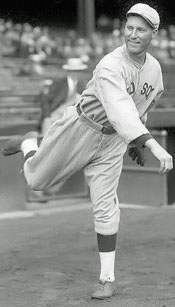
Red Ruffing, Red Sox
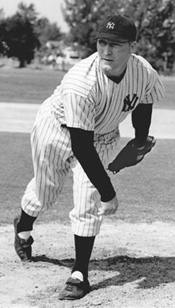
Red Ruffing, Yankees
|

Rookie Card 1973

Paul Owens
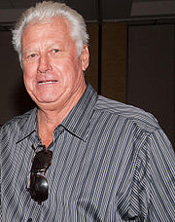
Dallas Green
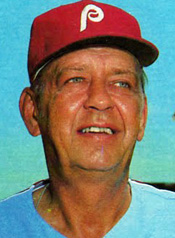
Danny Ozark

Larry Bowa
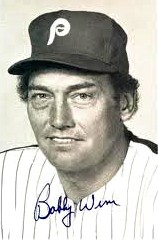
Bobby Wine
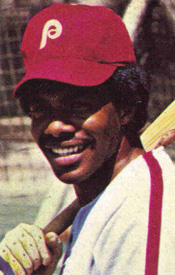
Dave Cash
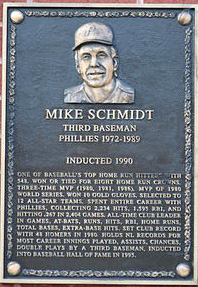
|
Rough Starts for Future Hall of Famers - II
Most future Hall of Fame players did reasonably well their rookie seasons although they may not have yet shown their potential for greatness. However, two future Cooperstown inductees - one a pitcher, the other a third baseman - did not do even "reasonably well" their first years in the bigs.
Part I
The Philadelphia Phillies selected Mike Schmidt as the 30th pick in the 1971 MLB draft.
- The previous pick had been none other than George Brett by the Kansas City Royals - two future Hall of Famers back-to-back in the same draft.
- After a brief appearance on the ML roster in 1973, Brett played the 1974 season with the Royals and compiled these numbers.
133 G, .282 BA, 90 RBI, 11 HR, 38 K, .363 Slg.%, .313 OBP
- Solid figures, but the next season, George led the AL in AB, H, and 3B and drove in 90.
- In 1976, Brett topped the league in hitting with a .333 BA.
Schmidt played a full ML season one year earlier than Brett but with much less success than George had the following campaign.
- After an injury-riddled high school career in football, basketball, and baseball, Mike walked on to the baseball team at the University of Ohio. Summer leagues after his senior year of high school and in subsequent years helped him develop into an All-American SS for the Bobcats, who made the College World Series his junior year.
- Despite concerns about his high number of strikeouts, the Phillies believed in his potential enough to use their second choice in the '71 draft on him.
- Schmidt played the latter part of the 1971 season at AA Reading. Then he was promoted to AAA Eugene (OR), where he hit .291 with 26 HRs but also stuck out 145 times.
- After a token (13 games) callup in 1972, Mike played 132 games for the Phils in '73 after the Phillies traded 3B Don Money to the Brewers in the offseason. Here are the depressing stats for his first full-season in the bigs:
.196 BA, 52 RBI, 18 HR, 136 K, 62 BB, .373 Slg.%, .324 OBP
- The Philadelphia fans showered Mike with boos as the season continued. No one could imagine this bum making the Hall of Fame someday, especially when he finished the season hitless in his last 26 at-bats to drop his average below .200.
- Schmidt had been rushed to the big leagues because the Phillies' front office - and scout Paul Owens in particular - thought he had the potential to be a Five Tool player. Minor League Director Dallas Green recalled: He could run like hell. He could steal bases. He had a great arm. He could field with the best of them, and he could hit and hit with power.
- With the last-place Phils going nowhere, management decided to go with youth. When Mike got off to a bad start in '73, Green and Owens wanted to send him back to AAA, but manager Danny Ozark pushed hard to keep him in the big leagues. Green: Danny recognized that this guy was going to be that good, and we weren't going anywhere anyway. You have to have patience with those guys. Ozark: Mike had proven he could hit AAA pitching; what was he going to prove down there? I said to Owens, "We might as well let him play." He had great hands, quick reactions, and his swing was like a Ben Hogan golf swing. The ball came off the bat like a rocket. He didn't muscle the ball. It was all timing and bat speed. He had so much talent, it was only a matter of time before he put it all together.
- While Ozark believed in Mike's potential, his manner of motivating him hurt rather than helped the struggling youngster. Danny called Schmidt to his office almost every day to give him advice. That approach might have worked with others, but it only made Mike more tense. He thought I was a stubborn kid. He treated me more like my father, disciplining me, yelling at me, using me as an example. ... I love Danny Ozark for caring about me as much as he did, but I'm not sure the way he cared about me helped me that year.
- The Phillie veterans were another source of irritation, especially Larry Bowa, whom he never got along with even after playing side by side on the left side of the infield for nearly a decade. Like many vets, Bowa thought the rookie 3B was spoiled and cocky. Schmidt: Larry was a great clubhouse needler, but he didn't have great timing. There were times when he didn't needle people, and I think he should have. There were times when he needled me that I thought it would be best to lay off. One time, I got so angry in a clubhouse in Houston that I almost wanted to kill him. I probably would have if there weren't four other players there to separate us.
Mike's improvement began immediately after the '73 campaign ended.
- Ozark invited him to spent two weeks with him in the batting cages at Veterans Stadium.
- Danny and the Phillies brass knew that Mike's problem was mental, not physical. He was a classic overthinker. Green: He always drove us crazy with that. ... He was stubborn in making adjustments and understanding hitting.
- Ozark: At first, I think Mike resented my postseason instruction, but he got over it when he realized the practice was for his own benefit. Nor was there anything drastic about the change I suggested in his hitting. It was just a slight change in the way he held the bat and his stance. The ability was there. It was just a matter of improving his concentration.
- Schmidt also benefitted from playing for Phillies coach Bobby Wine during winter ball in Puerto Rico. Wine took the opposite approach from Ozark. He was soft-spoken and gave positive reinforcement. Following Bobby's advice, Mike became more relaxed at the plate and cut down on his swing. He told Wine: All these years, I've thought you had to swing hard to hit it far. Trying to hit it far by swinging hard, that's what created all my problems. Now I know you can swing easy and get the same results.
- Another off-season change that helped Mike was getting married. By his own admission, he had led a playboy lifestyle as a bachelor rookie in the majors. Schmidt: Last year, I was single, and I'd never go home right after a game. Sometimes I'd be out until all hours of the morning. Things are different now that I have a wife to go home to. I'm not concerned with anything now except baseball and loving my wife.
When spring training began, Ozark nearly undid all the progress Wine had made with Schmidt.
- Danny decided Mike needed to change his stance. I've been thinking about the way you uppercut the ball, and I want you to try something different. I want you to hold the bat the way Nate Colbert does. I want you to start with it level instead of holding it upright. Colbert was the righthanded power-hitting 1B of the San Diego Padres. But Nate had struck out 146 times in '73. Why would Ozark want Schmidt to emulate him?
- Mike didn't react positively to his manager's proposal. He felt he had straightened out his stroke in winter ball. Even when Ozark insisted that a .196 hitter couldn't be stubborn and threatened to send him to AAA, Schmidt didn't acquiesce. Finally, Wine convinced Danny to leave the young slugger alone. Don't change his stance and back off the constant lectures.
- An offseason trade with the Pirates also contributed to Mike's success. New 2B Dave Cash brought leadership to the clubhouse and instilled muchneeded confidence in the entire team and its 3B in particular. Cash: Mike had all the tools but he didn't have the confidence. He was constantly doubting himself. And the fans rode him pretty hard. I spent a lot of time with him, trying to get him to block out the crowd.
The results were nothing short of spectacular.
- Here's Mike's stats for 1974, with league-leading numbers are in bold.
162 G, .282 BA, 160 H, 36 HR, 116 RBI, 138 K, 106 BB, .546 Slg.%, .395 OBP
- He needed to get off to a strong start and did. He started out batting eighth, where Ozark put him all of '73. But soon he moved up to 6th and then to 3rd, where he spent most of the year. His numbers made him a candidate for the NL All-Star team. Only one problem. His subpar showing in '73 resulted in his being left off the printed ballots. But a vigorous campaign by the Phillies earned him the most write-in votes in All-Star history. He finished second behind Ron Cey of the Dodgers. As a result, manager Yogi Berra chose Mike for the All-Star team. Yogi explained: The guy is having a fantastic year. I don't want to get shot next time I go to Philly.
- Schmidt: Last year I was in and out of the lineup, and when I was in , I probably tried too hard to do well because I was wondering if I'd be in the next day. I wanted to relax last season, but I couldn't. I was tight as a drum. This year, when I go to the plate, I'd say 70 to 80 percent of the time, I'm at ease just looking to hit the ball hard somewhere. When you come up to the plate that way, your natural instincts take over.
The rest, as they say, is history.
- Mike also led the NL in roundtrippers the next two seasons on his way to clouting 548 four-baggers over a 18-year career. He topped the NL in HRs five more times and stands as the all-time leader among 3Bs.
- Schmidt also won ten Gold Gloves at the hot corner.
- He was voted into the Hall of Fame in 1995 by virtue of appearing on 96.5% of the ballots.
Reference: Mike Schmidt: The Phillies' Legendary Slugger, Rob Maaddi (2010)
|
|












